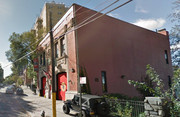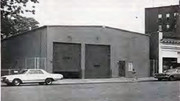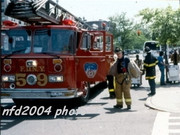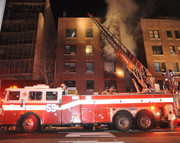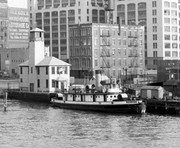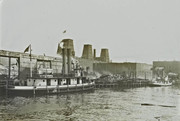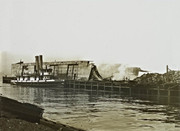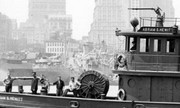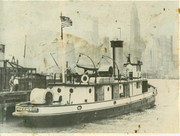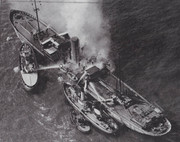
Fire Engineering - Epic of the East River
08/01/1958
"This is an epic of magnificent response to the call of duty."?New York Times. A fireboat flotilla assisted by land-based units?and radio?win a dramatic and dangerous engagement with uncontrolled fire."
FEW FIRES HAVE DEMONSTRATED the effectiveness of fire department radio, efficiently used, as that which involved the tanker Empress Bay, owned by the Petroleum Tankers Corp. of New York and the steamship Nebraska, owned by the Swedish Transatlantic Line of Gothenburg, in New York?s East River, in the early hours of June 25.
Firefighters are tactical athletes, and they require boots with maximum flexibility.
Scientific studies have proven that lighter weight and more flexible boots are safer, not just more comfortable. Firefighters are tactical athletes, and they require footwear that enhances their performance in the dangerous and multi-hazard environments in which they work.
But for the prompt and intelligent use of the New York Fire Department?s twoway radio and the strategy employed by both land and marine units of the department, aided by the U. S. Coast Guard and commercial craft, a disaster of unprecedented magnitude involving not only river craft but miles of busy waterfront might well have eventuated.
As it was, the blast and fire brought total destruction to the tanker and its 280,000-gallon cargo of gasoline, heavy damage to the S. S. Nebraska, and came within an ace of wrecking the center of the Manhattan Bridge, when flames which flared aloft over 160 feet ignited it. Also seriously damaged was the fireboat William Gaynor (Engine 77), first of the fireboat fleet to respond, and prominent in the rescue of the crews of the burning vessels.
It all began about midnight June 24, when the two ships collided just east of the Manhattan Bridge. The freighter was bound from New Haven to Newark; the tanker from the Bayway Refinery, Linden, N. J., to Mount Vernon, N. Y. The 172-foot tanker was ripped open midships by the heavier vessel and its gasoline cargo spilled onto the river and ignited. As the two craft remained locked together, the freighter was quickly involved. It is estimated over 1,000 feet of the river?s surface was soon covered by the flaming fuel, which lighted up the dockside on both Brooklyn and Manhattan shores.
Alarms come thick and fast
Brooklyn Fire Headquarters received the first notification of the disaster at 12:23 a.m. on the 25th, when the fireboat William Gaynor (Engine 77, Brooklyn) tapped out 2-2-2 77 over the boat telegraph circuit, reporting quickly by radio that the company was beaded toward the blaze. One minute later, the Manhattan Fire Alarm Office received Box 128 (Batavia and James streets) which marks the location of Pier 31, East River. Two other boxes, 206 and 126 were snapped at almost the same time, followed by a ?Class 3? building box. The telephone switchboards at Manhattan and Brooklyn fire communications headquarters were soon loaded with numberless telephone calls, some more or less incoherent but sufficient to convince the busy operators and dispatchers that a critical situation existed on the river, about opposite Pier 29 on the Manhattan side.
The assignment for Box 128 called for Engines 12, 9, 32, 7; Ladders 6 and 1 and Battalion Chiefs 2 and 1. Engine 12 under Captain Smiles and Ladder 6 under Lieutenant O?Shea reached the box within two and a half minutes. Chiefs Richmond of the 2nd and Driscoll of the 1st also made quick response, the former reporting via radio such meagre details as were available upon reaching the dockside. Anticipating possible contact between the drifting blazing ships and the Manhattan shore, Engine 12 was directed to connect to and supply, the standpipe of Pier 29 East River and to place its deck pipe in position for operation. Engine 7 did likewise to protect Pier 31.
Meantime, the Gaynor, commanded by Captain Eugene Kenny, was in touch with Brooklyn and ?Citywide? communications headquarters by radio, as it covered the half mile from its berth to the blazing vessels. At 12:26 a.m., ?Citywide? was informed by Engine 77 that an oil boat was ablaze between the Manhattan and the Brooklyn Bridges, At that time, Captain Kenny requested at least two additional boats be dispatched. Two minutes later, Engine 57, the fireboat John D. McKean, Captain Gallagher, from the Battery, and Engine 86, the John J. Harvey, Lieutenant Farrell, from its Hudson River berth, were en route.
All fireboats summoned
Assistant Chief of Department, Thomas P. O?Brien (who also heads up the bureau of communications), in charge of the department at the time, had been notified by headquarters and was headed for Box 128, which location was to become the focal point of operations.
Informed by radio of the critical situation materializing on the river Chief O?Brien radioed for all available boats to be dispatched to Box 128 (Pier 31). Within the next four minutes, the fireboats John Purroy Mitchel, Engine 232, Lieutenant Albertelli; the Thomas Willett, Engine 78, Lieutenant Gallagher; the James Duane, Engine 85, Lieutenant Becker; the Fire Fighter, Engine 223, Acting Lieutenant Farrell and the Sylvia Wilkes, Engine 51 (newest of the fireboat fleet), Lieutenant Brickfield, were heading full speed for the scene.
Radio reports also reached Fire Commissioner Edward F. Cavanagh, Jr. and Fire Chief George David, only recently appointed head of the department, and Deputy Chief Alfred Mendey, First Division which includes the Battalions 1 and 2. On the Brooklyn side, Deputy Chief-inCharge of the Borough Edward McGarry, and the heads of the 34th, 32nd, and 31st Battalions were informed by radio of events. The head of the Marine Battalion (25), Acting Battalion Chief R. L. Olsen, responding with the tender Smoke. This new boat (FIRE ENGINEERING June 1958) was destined to play an important part in the action, its movements together with those of the entire fireboat flotilla, being directed by radio.
Arriving at dockside, Chief O?Brien?s first act was to check the various sources of information coming in and to size up the general situation. At that time the locked vessels, forming a giant floating torch, were yawing widely over the river, in the grip of the strong ebb tide. Passing directly under the Manhattan Bridge, heat and flames ignited ties and all other combustibles in its center span. At the time, it was impossible to foresee just where the floating conflagration would wind up, or what it would ignite on contact or heat by radiation.
It was determined from reports by the Gaynor, that a large tanker and a steamship, the Nebraska, were involved, and drifting out of control, interlocked. The fireboat by then had every one of its deck pipes at work, either trying to beat back the surface spill fire or, more important at the moment, to protect members of the crew of the Nebraska, who were in imminent danger from the flames spreading on that ship. That vessel was fully involved on the port side, and flames were working their way into the crew?s quarters and passenger cabins and other sections of the vessel. Only the engine-room crew were below decks?and their fate was not known at the time. Some of the crew of the Nebraska had gone overboard in the effort to escape the flames.
In the maneuver to save the crew of the Nebraska, many of whom were forced to the extreme stern, the Gaynor was caught under the big ship?s fantail, the propeller of the latter cutting a deep gash in the fireboat?s hull, flooding the 44-year-old craft?s boiler room. Captain Kenny, however, not only managed to get most of the Nebraska?s crew off the ship, but was able to bring them, with his boat, to Pier 31, where immediate and successful steps were taken to prevent the Gaynor from sinking. This operation well rates a story in itself.
Meanwhile, Acting Chief Olsen, in the tender Smoke, had reached the scene, ahead of the two flreboats requested by Captain Kenny by radio. He further informed the communications bureau of the worsening situation. He was directed to pick up Chief O?Brien at Pier 31.
While heading for the pier Chief Olsen performed a rescue for which he has since been cited. The Smoke encountered 17-year-old Walter Mattefecht, a member of the Nebraska?s crew floundering in the water. Suffering burns be had jumped from the burning ship, and was further threatened by the spreading blaze on the water.
When Mattefecht was unable to use the life preserver thrown to him from the Smoke, because of his injuries, Chief Olsen divested himself of heavy clothing, dove in after him, and brought him to the side of the Smoke where they were pulled aboard. Mattefecht was taken to the hospital as soon as the tender reached the Pier.
Action directed from fireboat
Chief O?Brien, his aide and others reached the burning ships, by means of the busy Smoke and established headquarters aboard the fireboat McKean, from which point the marine fire control operations were directed. These had three immediate objectives, the first being to protect and rescue any members of the crews of both burning vessels that might be aboard; the second, to confine the spill fire spreading from the burning tanker; the third, to attempt to extinguish the fire on the underside of the Manhattan Bridge.
Brooklyn Box 471 (Fulton and Columbia Heights?at the Brooklyn end of the Manhattan Bridge) was snapped at 12:26 a.m. This was responded to by Engines 205, 208, 224, 77 (fireboat Gaynor, already en route) Rescue 2; Ladders 118 and 110; Deputy Chief Timothy Driscoll of the 10th Division and Chiefs J. R. Travell and A. D. Steier of the 31st and 32nd Battalions respectively.
Borough Chief McGarry, and Deputy Chief Driscoll?10th Division, assumed charge of extinguishing the bridge blaze, and patrolling the Brooklyn waterside for possible contact of the blazing vessels. Land units of the 2nd Battalion tackled the bridge fire from the Manhattan side. Engine 9 was ordered to respond and supply the bridge standpipe from the Manhattan end, stretch two lines and use its booster on the fire.
On the Brooklyn approach, Engine 208 stretched and operated three lines on the bridge to extinguish fire along tracks and ties. Ladder 118 assisted in stretching lines and in overhauling the burned section. Engines 205 and 224 were employed to supply the bridge standpipe from the Brooklyn side. Ladder 118, together with units of the 32nd Battalion, were directed to examine the shore line. Like units on the Manhattan side, the operation was kept fluid?the various companies not being permitted to firm up in any one location.
The same fluid condition was maintained on the Manhattan side of the East River, where Chief Mendey, Division 1, supervised patrols and later, salvage operations on the Nebraska. He also participated in the action to save the sinking fireboat Gaynor. Only the two companies covering Piers 31 and 29 remained fixed for any time. The balance were occupied in patrol or bridge operations.
Chief O?Brien had directed assignments from three engine and two ladder companies to be transported to the Nebraska as soon as the fire on that ship was darkened down, and the vessel could be boarded to aid the several fire boat crews in final extinguishment and search for victims. This was done. Members of Rescue 1, Manhattan, after treating casualties brought ashore on the Gaynor, responded to the Nebraska. Their assistance, together with personnel detailed from various engine and ladder companies, was welcomed in advancing lines and examining the ship?s interior. In company with others operating on the Nebraska, these men wore demand-type respiratory protective equipment.
To secure the manpower to reinforce the fireboat crews, and to further patrol the Manhattan waterfront, Chief O?Brien had ordered a second alarm, at 12:53 a.m. (Box 128). This brought Engines 31, 10, 17, 27; Rescue 1; and Ladder 10. It also resulted in these relocations: Engines 221 to 31; 209 to 9; 256 to 7; Ladders 18 to 6 and 20 to 10.
Using heavy fog patterns and powerful straight streams to sweep back floating flames from the fireboats, which were positioned completely around the blazing vessels, the fire on the Nebraska was soon sufficiently cooled to permit fire fighters to gain its decks by means of hook ladders. Heavy 3 1/2-inch lines were thereupon taken aboard and broken into smaller lines which were worked into the interior sections of the ship to knock out fire in that area.
Cavanagh and David in action
While these fire fighting operations aboard the Nebraska were being continued, Fire Commissioner Cavanagh and Chief David arrived, and the latter took command. Investigation revealed that the engineroom crew and the captain of the Nebraska were still aboard and safe. Careful checkup showed all 36 crewmen of that ship accounted for. Two of the Empress Bay?s crew were missing and believed dead (their bodies were taken from the sunken tanker several days later).
It required eight hand fines aboard the Nebraska to contain and control the fire in the crew?s and passengers? quarters, the cargo, storerooms and other parts of the vessel. More than 20 turrets and deck pipes were employed by the fireboats in overcoming the main body of the blaze in the gasoline slick and on the two vessels. In this effort, the fireboat Mitchel (Engine 232), was given the task of tackling the fire on the underside of the Manhattan Bridge. Two of the boat?s big deckpipes were discharged under high pressures and, although the streams reached the bridge structure approximately 160 feet above, the strong current in the river made it difficult for the boat to effectively hold its position. The action therefore was broken off. Prior to all this, power on the bridge, had been cut off.
During the intensified marine engagement, another disaster was narrowly averted when a second tanker loaded with flammables blundered into the scene, reportedly actually brushing the wreckage. Fortunately, a direct collision was averted, but fire fighters had an anxious few moments. U. S. Coast Guardsmen were alerted at their station about a half mile away, by the geyser of flame that shot up. Within minutes, 11 Coast Guard boats were heading for the blaze.
The Coast Guard rendered invaluable assistance both during the fire control operations and later, when the fumes from still escaping cargo of the sunken Empress Bay continued to be a menace to navigation. For 24 hours after the crash the Empress Bay remained half submerged with her blistered bow projecting above water. Then she sank out of sight. The Coast Guard shut off marine traffic on the East River after a conference at 4:00 a.m. between Captain George W. Holsman and Chief O?Brien. At 8:55 a.m. after another conference between Coast Guard and fire department officials including Deputy Chief Hugh A. Halligan at that time in charge of the Marine Division, it was decided to open one side of the river. All craft was warned by the Coast Guard to take precautions in passing near the wreck. When all danger of reignition of fumes was past, buoys were placed around the sunken tanker, which was abandoned, a total loss.
Coast Guard cooperation was directed by Captain Holtzman, acting captain of the port at the time. The vessels under his command range from fire fighters of the tug type to 42-footers equipped with foam throwing equipment and other gear. The Coast Guard?s headaches continued after the fire, when it was necessary to control the miscellaneous river traffic, particularly the many sight-seeing and excursion boats. No smoking was ordered on all craft during the danger period.
Credit of fire fighters and press is also given the tug Dalzellera, Captain Bert Deeley, which assisted in rescue efforts and in disengaging the two locked vessels.
Fireboat Gaynor saved
Another highlight of the action was the successful effort to save the foundering Gaynor, at Pier 31. Even before the scarred Nebraska had been towed around the Battery to Pier 26 North River, where overhauling operations were completed, firemen were concentrating on saving the Gaynor. Prominent in this action were supervising engineers who rushed eductors and other salvage gear to the scene of the fire department?s emergency utilities unit. In these operations, fire department pumpers drafted directly from the waterlogged engine room which at one time contained 9 feet of water. Engines 7, 17, 27, 31 and 32, together with units of the Marine Division, Ladder 1 and the EUU were able to lower the water level to permit temporary partial plugging of the leak, whereupon the Gaynor was towed to the Todd Shipyard in Hoboken, escorted by Engines 232 and 86, operating eductors all the way.
Both Commissioner Cavanagh and Chief David, together with Chief Mendes, took part in supervising these efforts to save the Gaynor, and later, to overhaul the burned, blistered and still-smouldering Nebraska which reached Pier 26 under its own
The Coast Guard rendered invaluable assistance both during the fire control operations and later, when the fumes from still escaping cargo of the sunken Empress Bay continued to be a menace to navigation. For 24 hours after the crash the Empress Bay remained half submerged with her blistered bow projecting above water. Then she sank out of sight. The Coast Guard shut off marine traffic on the East River after a conference at 4:00 a.m. between Captain George W. Holsman and Chief O?Brien. At 8:55 a.m. after another conference between Coast Guard and fire department officials including Deputy Chief Hugh A. Halligan at that time in charge of the Marine Division, it was decided to open one side of the river. All craft was warned by the Coast Guard to take precautions in passing near the wreck. When all danger of reignition of fumes was past, buoys were placed around the sunken tanker, which was abandoned, a total loss.
Coast Guard cooperation was directed by Captain Holtzman, acting captain of the port at the time. The vessels under his command range from fire fighters of the tug type to 42-footers equipped with foam throwing equipment and other gear. The Coast Guard?s headaches continued after the fire, when it was necessary to control the miscellaneous river traffic, particularly the many sight-seeing and excursion boats. No smoking was ordered on all craft during the danger period.
Credit of fire fighters and press is also given the tug Dalzellera, Captain Bert Deeley, which assisted in rescue efforts and in disengaging the two locked vessels.
At the pier, engine and ladder companies went to work on it. Aerial ladders were raised against the ship from the pier, lines taken aboard and the last vestiges of fire extinguished.
Fire department records show two of the crew of the Empress Bay killed. Thirty-six other crewmen of both ships were hospitalized, most of them with burns. Four fire fighters suffered injuries. They were Captain E. E. Kenny, Engine 77; Firemen E. P. McCarthy, Engine 77; C. T. Schubert, Engine 208 and Philip Prail, Ladder 9 (detailed to Rescue 1).
Summary
Response?A total of 37 Fire Department units were engaged during the approximately 6-hour operation. They included 21 engine companies; eight fireboats; eight ladder companies; two rescue units; mask service unit; searchlight unit; gasoline oil unit; ambulance and emergency utility unit. Also the tender Smoke.
Operations?Seven hand lines and 20 turret streams were employed in extinguishing operations. The fire department has acknowledged with thanks, the cooperation of the Coast Guard, police department, civilian tugs and harbor craft.
Casualties?Two dead and five injured on the Empress Bay; 31 injured on the Nebraska; an indirect casualty was William V. Finn, photographer of the New York Journal American who was fatally stricken while photographing the action.
Losses?Not fully determined at this writing, on the Empress Bay and Nebraska, approximately $500,000. On the Manhattan Bridge, not given but estimated at moderate. On the William Gaynor, loss may run as high as $50,000.
Cause?Responsibility for the collision not determined at this writing. Coast Guard investigating.
The editors gratefully acknowledge the assistance of the New York Fire Department particularly Commissioner Edward F. Cavanagh, Jr.; Chief of Department George David; Assistant Chief Thomas P. O?Brien; Chief Supervising Engineer John Jordon and the staff at Manhattan Fire Alarm Communications Office for their special cooperation
https://www.fireengineering.com/articles/print/volume-111/issue-8/features/epic-of-the-east-river.html
Firehouse - Baptism of Fire - FDNY probationary firefighter Lawrence Principato personal account of fire:
https://www.firehouse.com/home/news/10545203/baptism-of-fire














